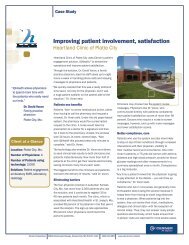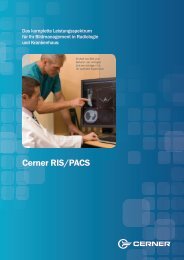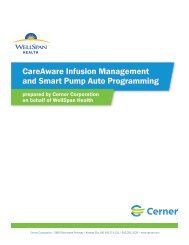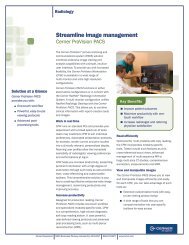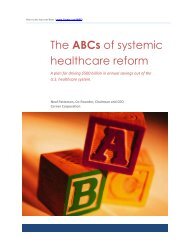The ABCs of systemic healthcare reform - Cerner Corporation
The ABCs of systemic healthcare reform - Cerner Corporation
The ABCs of systemic healthcare reform - Cerner Corporation
- No tags were found...
Create successful ePaper yourself
Turn your PDF publications into a flip-book with our unique Google optimized e-Paper software.
interest rates regularly reset every 7-35 days under an auction system. Due to the lack <strong>of</strong> availability <strong>of</strong> observable market<br />
quotes on the Company’s investment portfolio <strong>of</strong> auction rate securities, the Company utilizes valuation models including those<br />
that are based on discounted cash flow streams, including assessments <strong>of</strong> counterparty credit quality, default risk underlying<br />
the security, discount rates and overall capital market liquidity. <strong>The</strong> valuation is subject to uncertainties that are difficult to<br />
predict.<br />
A considerable amount <strong>of</strong> judgment and estimation is applied in the valuation <strong>of</strong> auction rate securities. In addition, the<br />
Company also applies judgment in determining whether the marketable securities are other-than-temporarily impaired. <strong>The</strong><br />
Company typically considers the severity and duration <strong>of</strong> the decline, future prospects <strong>of</strong> the issuer and the Company’s ability<br />
and intent to hold the security to recovery.<br />
Goodwill<br />
<strong>The</strong> Company accounts for its goodwill under the provisions <strong>of</strong> Statement <strong>of</strong> Financial Accounting Standards (SFAS) No. 142,<br />
“Goodwill and Other Intangible Assets.” As a result, goodwill and intangible assets with indefinite lives are not amortized but are<br />
evaluated for impairment annually or whenever there is an impairment indicator. All goodwill is assigned to a reporting unit,<br />
where it is subject to an annual impairment test based on fair value. <strong>The</strong> Company assesses goodwill for impairment in the<br />
second quarter <strong>of</strong> each fiscal year and evaluates impairment indicators at each quarter end. <strong>The</strong> Company assessed its<br />
goodwill for impairment in the second quarters <strong>of</strong> 2008 and 2007 and concluded that no goodwill was impaired. <strong>The</strong> Company<br />
used a discounted cash flow analysis to determine the fair value <strong>of</strong> the reporting units for all periods. Goodwill amounted to<br />
$146,666,000 and $143,924,000 at January 3, 2009 and December 29, 2007, respectively. If future, anticipated cash flows<br />
from the Company’s reporting units that recognized goodwill do not materialize as expected the Company’s goodwill could be<br />
impaired, which could result in significant write-<strong>of</strong>fs.<br />
Income Taxes<br />
In 2006, the FASB issued Interpretation No. 48 (FIN 48), “Accounting for Uncertainty in Income Taxes – an Interpretation <strong>of</strong><br />
SFAS No. 109.” FIN 48 clarifies the accounting for uncertainty in income taxes recognized in an enterprise’s financial<br />
statements in accordance with SFAS No. 109, “Accounting for Income Taxes.” FIN 48 also prescribes a recognition threshold<br />
and measurement <strong>of</strong> a tax position taken or expected to be taken in an enterprise’s tax return. Management makes a number<br />
<strong>of</strong> assumptions and estimates in determining the appropriate amount <strong>of</strong> expense to record for income taxes. <strong>The</strong>se<br />
assumptions and estimates consider the taxing jurisdiction in which the Company operates as well as current tax regulations.<br />
Accruals are established for estimates <strong>of</strong> tax effects for certain transactions, business structures and future projected<br />
pr<strong>of</strong>itability <strong>of</strong> the Company’s businesses based on management’s interpretation <strong>of</strong> existing facts and circumstances. If these<br />
assumptions and estimates were to change as a result <strong>of</strong> new evidence or changes in circumstances the change in estimate<br />
could result in a material adjustment to the consolidated financial statements. <strong>The</strong> Company adopted FIN 48 effective at the<br />
beginning <strong>of</strong> 2007. <strong>The</strong> adoption <strong>of</strong> FIN 48 did not have a material impact on <strong>Cerner</strong>’s consolidated financial position. See Note<br />
11 to the consolidated financial statements for additional disclosures related to FIN 48.<br />
Our management has discussed the development and selection <strong>of</strong> these critical accounting estimates with the Audit Committee<br />
<strong>of</strong> our Board <strong>of</strong> Directors and the Audit Committee has reviewed the Company's disclosure contained herein.<br />
Item 7A. Quantitative and Qualitative Disclosures about Market Risk<br />
At January 3, 2009, the Company had a £65,000,000 ($94,556,000 at January 3, 2009) note payable outstanding through a<br />
private placement with an interest rate <strong>of</strong> 5.54%. <strong>The</strong> note is payable in seven equal installments beginning in November 2009.<br />
Because the borrowing is denominated in pounds, the Company is exposed to movements in the foreign currency exchange rate<br />
between the U.S. dollar and the Great Britain pound. <strong>The</strong> note was entered into for other than trading purposes. Beginning in<br />
2006, at the beginning <strong>of</strong> each quarterly period, the Company designated a portion (between £60 million and £63 million during<br />
the year) <strong>of</strong> its debt (£65 million) that is denominated in Great Britain Pounds, to hedge its net investment in a subsidiary in<br />
England. During 2007 and 2008 the Company designated all £65 million <strong>of</strong> its debt that is denominated in Great Britain<br />
Pounds.<br />
Item 8. Financial Statements and Supplementary Data<br />
<strong>The</strong> Financial Statements and Notes required by this Item are submitted as a separate part <strong>of</strong> this report.<br />
Item 9. Changes in and Disagreements with Accountants on Accounting and<br />
Financial Disclosure<br />
N/A<br />
49






